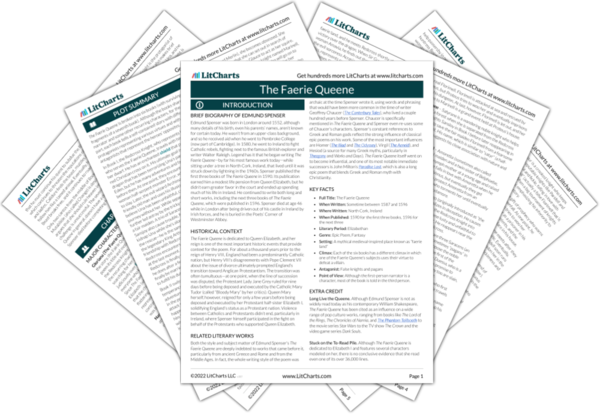Throughout Edmund Spenser’s The Faerie Queene, evil characters disguise their identities and tell lies in order to trick heroic characters into doing things they wouldn’t otherwise do. Archimago in Book I is one of the earliest examples of this type of trickster character, using magic and some mischievous sprites in order to trick the Redcross Knight into believing that his chaste lady Una has been unfaithful to him. Even more extreme is the Blatant Beast that Sir Calidore pursues in Book VI. It is slander personified: a doglike monster with many tongues, some human and others animal, in order to represent the many ways that slander ruins the reputations of knights and ladies with its lies. Though Calidore tames the beast for a while, the poem ends with the beast let loose again, showing the enduring and uncontainable power of deception.
According to Spenser, the most dangerous thing about deception is that it can make an evil thing appear like a good one—or even better than a good one. This is most humorously illustrated with the case of false Florimell in Book IIII, where the fair maiden Florimell competes in a beauty contest against a replica of herself (made from snow for skin, lamps for eyes, and gold wire for hair) that is controlled by an evil sprite. The episode shows how deception can be seductive—but it also shows how the allure of deception is temporary, since false Florimell is eventually outed as a fake, just like previous trickster characters like Archimago and Duessa get their comeuppance. In The Faerie Queene, Spenser portrays how the glamor of lies and deception can lead even virtuous characters astray, but he also shows how true virtue and honesty win out in the end.
Deception and Lies ThemeTracker

Deception and Lies Quotes in The Faerie Queene
Young knight, what ever that does armes professe,
And through long labours huntest after fame,
Beware of fraud, beware of ficklenesse,
In choice, and change of thy deare loved Dame
Come, come away, fraile, feeble, fleshly wight,
Ne let vaine words bewitch thy manly hart,
Ne divelish thoughts dismay thy constant spright.
Said Guyon, See the mind of beastly man,
That hath so soone forgot the excellence
Of his creation, when he life began,
That now he chooseth, with vile difference
To be a beast, and lack intelligence
Who through foresight of his eternall skill,
Bad her from womankind to keepe him well:
For of a woman he should have much ill,
A virgin strange and stout him should dismay, or kill.
Then was that golden belt by doome of all
Graunted to her, as to the fairest Dame.
Which being brought, about her middle small
They thought to gird, as best it her became;
But by no meanes they could it thereto frame.
For eqaull right in equall things doth stand,
For what the mighty Sea hath once possest,
And plucked quite from all possessors hand,
Whether by rage of waves, that never rest,
Or else by wracke, that wretches hath distrest,
He may dispose by his imperial might.
Where being layd, the wrothfull Britonesse
Stayd not, till she came to her selfe againe,
But in revenge both of her loves distresse,
And her late vile reproach, though vaunted vaine,
And also of her wound, which sore did paine,
She with one stroke both head and helmet cleft.
When they had seene and heard her doome a rights
Against Duessa, damned by them all;
But by her tempred without griefe or gall,
Till strong constraint did her thereto enforce.
But mongst them all was none more courteous Knight,
Then Calidore, beloved over all,
in whom it seemes that gentlenesse of spright
And manners mylde were planted naturall
No wound, which warlike hand of enemy
Inflicts with dint of sword, so sore doth light,
As doth the poysnous sting, which infamy
Infixeth in the name of noble wight:
For by no art, nor any leaches might
It ever can recured be againe;
And after all, for greater infamie,
He by the heeles him hung upon a tree,
And baffuld so, that all which passed by,
The picture of his punishment might see,
And by the like ensample warned bee
Ne may this homely verse, of many meanest,
Hope to escape his venomous despite,
More than my former writes, all were they clearest
From blamefull blot, and free from all that wite,
With which some wicked tongues did it backebite,
and bring into a mighty Peres displeasure,
That never so deserved to endite.
Therefore do you my rimes keep better measure,
And seeke to please, that now is counted wisemens threasure.











